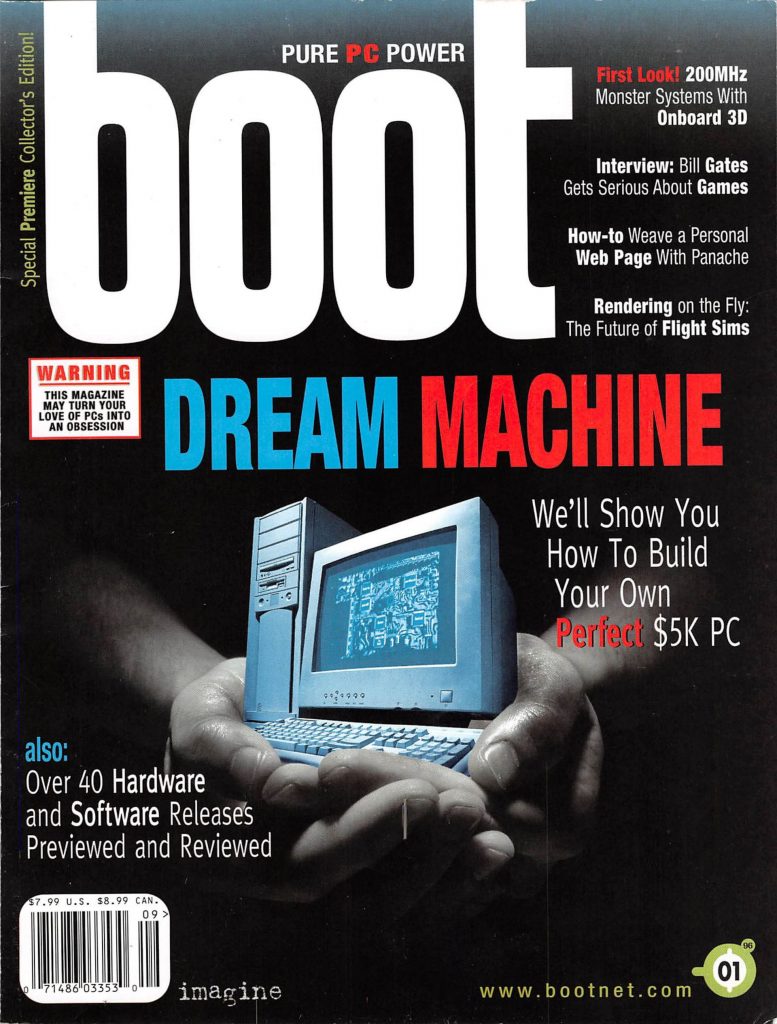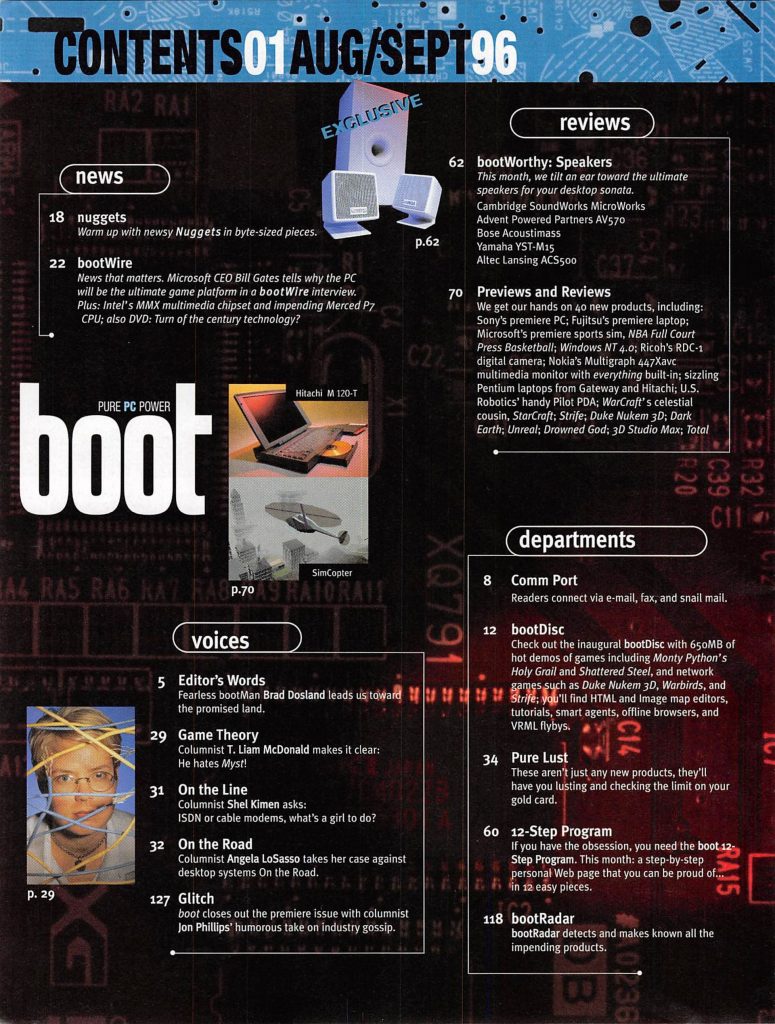Source: boot – Issue Number 1 – August/September 1996
Maximum PC and its predecessor ‘boot’ has always been by far my favorite computer related magazine. Maximum PC is still published today which is surprising given the state of magazines in general. I buy an issue occasionally and they seem to have maintained their quality fairly well.
Anyway, the August/September 1996 issue was the very first one and featured the first ‘Dream Machine’ which they’ve had every year since. At times they have gotten a bit absurd with that with things like multi-thousand dollar custom cases, etc. but I digress. This issue includes:
news
- nuggets – Brief news bits about microchipping pets, The Court of Last Resort, RetireReady! retirement guide on CD-ROM, Duckman: The Legend of the Fall CD-ROM, the first online diocese, The Otherside Gaming Facility with ‘simulation pods’ featuring Duke Nukem 3D, Descent II, ATF and Warbirds; The Dissectible Human CD-ROM, Aeon Flux, Movie Maker (the game), and more.
- bootWire – “News That Matters” featuring and interview with Bill Gates explaining why the PC (and Windows 95) is the ultimate game platform; MMX arrives to accelerate multimedia applications; Merced set to replace Pentium Pro; first DVD-ROM drives and movie players set to ship by the end of the year; and more.
reviews
- bootWorthy: Speakers – A look at the Altec Lansing ACS500, Yamaha YST System 45, Bose Acoustimass, Advent AV570, and Cambridge SoundWorks MicroWorks. All of which were apparently reasonable choices depending on your specific needs and desires.
- Previews
- Sony Jumps Into the PC Market – Sony enters the PC market with the PCV-70 which features a 166MHz Pentium, 16MB of RAM and a 2.1GB hard drive and the PCV-90 which features a 200MHz Pentium, 32MB of RAM and a 2.5GB hard drive. boot’s summary “Pretty case; little innovation” says it all. They also weren’t cheap at $2,000 to $3,000.
- Tomb Raider – A preview of what would become one of the most popular games of all time.
- The Outer Limits On-Line – Preview of an online role-playing game based on The Outer Limits TV show.
- Star Trek: Star Fleet Academy – Preview of a Star Trek game for those that have always wanted to command a Trek ship.
- Dark Earth – Interview with Kevin Bachus, Mindscape’s international development manager, about Dark Earth.
- City of Lost Children – Preview of an adventure game based on the French film of the same name.
- Fujitsu Notebook Series – Fujitsu enters the U.S. computer market with Pentium powered notebook computers costing up to $5200.
- StarCraft Preview of one of the most popular RTS games ever made.
- SimCopter – Interview with Will Wright about the upcoming SimCopter.
- Drowned God – Preview of an adventure game in which you must fined the Ark of the Covenant, the Holy Grail, the Rod of Osiris, and the Philosopher’s Stone.
- Unreal – Preview of one of the most well known FPS series ever made. There were a LOT of true classics made circa 1996. Fully texture-mapped polygons even on a Pentium 90 with no 3D acceleration!
- NBA Full Court Press – Preview of this basketball game from Microsoft.
- Syn Factor – Preview of this adventure game involving a missing spaceship crew.
- Windows NT 4.0 – First look at the newest version of Microsoft’s professional OS.
- Reviews
- Gateway 2000 Solo – I was a Gateway 2000 fan so if I could have afforded one ($5,599 for this one), this might have been the one I chose. It features a 120MHz Pentium, 40MB EDO DRAM, 1.2GB EIDE hard drive, 4x CD-ROM drive, a 11.3-inch active matrix display capable of 800×600 at 256 colors or 640×480 at 64,000 colors.
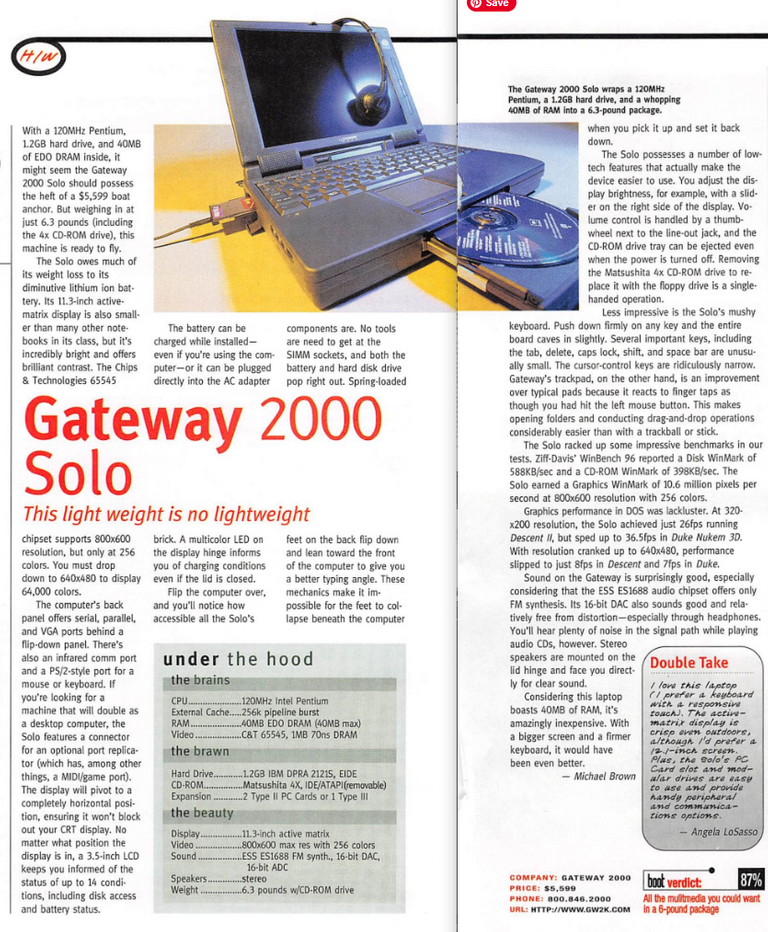
-
- Hitachi M-120T – Another laptop choice, this one featuring a 120MHz Pentium, 16MB EDO RAM, 1GB hard drive and more for only $5,299.
- Strife – Making an RPG with the Doom engine.
- d-Time 95; SpeedyROM – Two programs designed to cache data from your CD-ROM to make it faster.
- 512k Pilot – One of the earlier Palm Pilot devices. Laughable by today’s standards perhaps but pretty amazing then.
- WingMan Warrior – Joystick designed to replace the keyboard and mouse for FPS games.
- PC ProgramPad – Somewhat reminiscent of the SNES or Genesis game pads but programmable.
- Nokia Multigraph 447Xavc – An interesting 17-inch Trinitron CRT monitor with built-in camera and speakers for only $999.
- Chaos Overlords – A turn based strategy game in which you take the role of a futuristic crime lord.
- Nine Worlds – Explore the solar system with Patrick Stewart as your guide.
- Frank Lloyd Wright: Presentation and Conceptual Drawings – A rather expensive collection of CDs with a large amount of Frank Lloyd Wright’s drawings.
- Battleground 3: Waterloo – Strategy game featuring 22 scenarios including variations of the Battle of Waterloo.
- Gateway 2000 P5-166XL – I had a 486 DX2/66 at the time but if I had been upgrading in the Summer/Fall of 1996, then this is the machine I probably would have gone for. It features a 166 MHz Pentium and 16MB of EDO RAM.
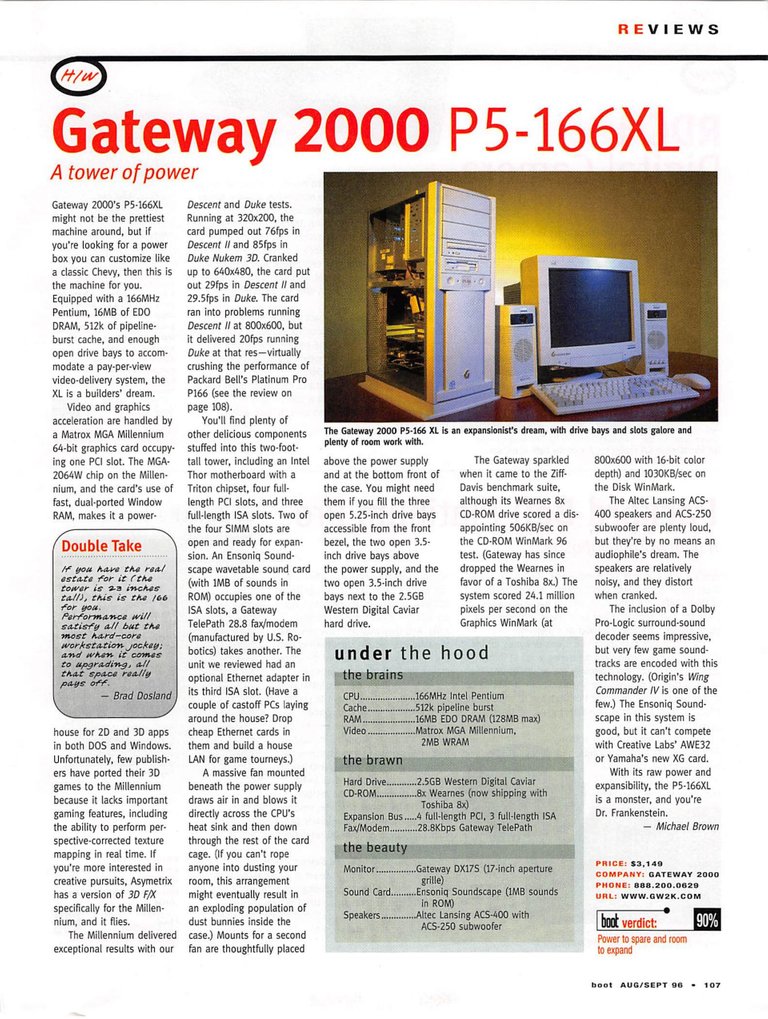
-
- RDC-1 Digital Camera – A $3,000 digital camera that features less than half a megapixel of resolution.
- Packard Bell Platinum Pro – I always had a negative perception of Packard Bells and this review doesn’t change that. It’s not that much cheaper than the Gateway either. Despite having the same 166 MHz Pentium is was much slower due to its older asynchronous cache design and lower end video card. Plus it used the horrible LPX motherboard form factor instead of ATX.
- Hewlett-Packard Pavilion 7130P – A 133MHz based machine that features a built-in scanner for scanning photo prints (up to 5×7).
- Duke Nukem 3D – Classic early FPS 2nd in fame perhaps only to Doom.
- Web.Designer – Set of web creation tools to aid you in creating web sites.
- Total Mayhem – Compared, unfavorably, with Crusader No Remorse.
- 3D Studio Max – Excellent but VERY expensive modeling and animation package.
- Color QuickCam – Webcams were just becoming a thing.
voices
- Editor’s Words – An introduction to boot.
- Game Theory – Opining the use of style over substance in modern gaming with plenty of criticism aimed at Myst and Macromedia Director.
- On the Line – ISDN vs. cable modems.
- On the Road – The advantages of laptops and mobile computing.
- Glitch – Odd editorial and rumors around the computer tech industry.
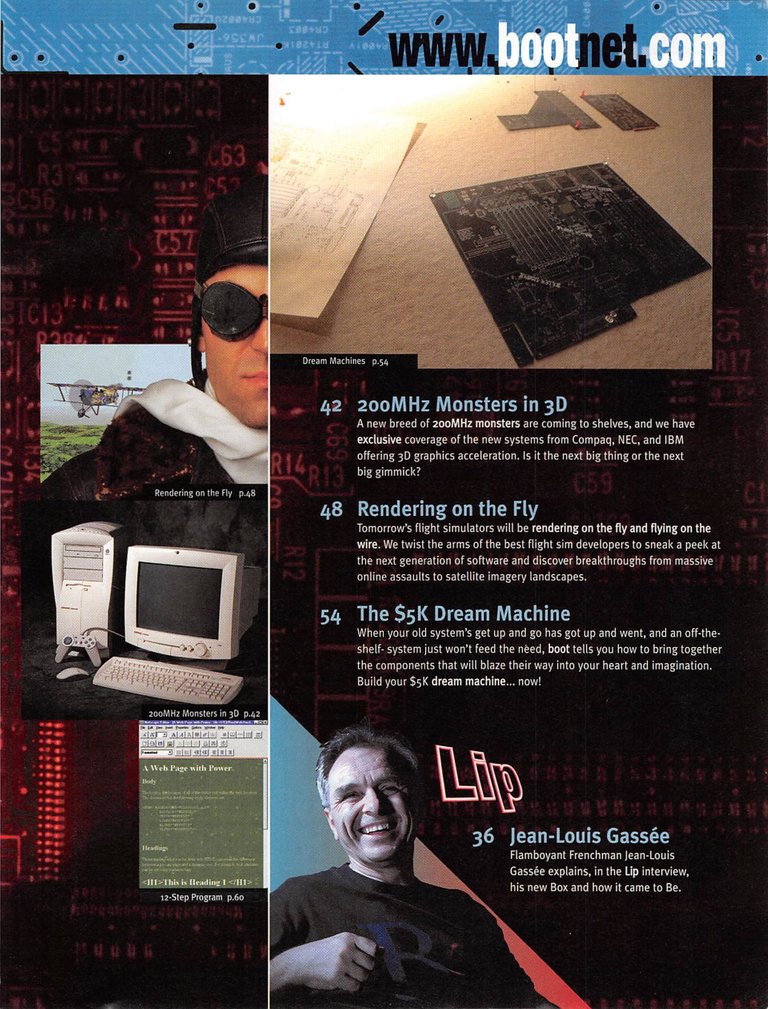
departments
- Comm Port – It seems that subscribers of the recently defunct CD-ROM Today magazine/CD combo were switched over to boot as that’s where the letters in the first issue come from.
- bootDisc – The cover CD includes the first episode of Quake, a demo of Shattered Steel, the first level of Duke Nukem 3D, WarBirds, a demo of Strife, Adobe Acrobat Reader 3.0 Beta, a demo of AnchorPage, PoliForm, Hijaak Morph, Calamus, video interview highlights with JEan-Louis Gassee, father of the BeBox, and more.
- Pure Lust – Featuring Sony’s Plasmatron TV, U.S. Robotics’ Conference Link C51000 speakerphone, Fieldworks’ rugged laptops that can withstand 100G shocks and temps from 5 degrees F to 122 degrees F, Ricochet modem (sort of an early wi-fi technology), the Roland Personal Drum Assistant, Sharp’s Zaurus ZR-5800FX PDA, Panasonic’s new CF-62 laptop featuring a PD rewriteable optical drive, Panasonic’s KX-P5600 printer/scanner/copier, and Zenith’s HomeWorks Universal Cable modem (4Mbps internet!).
- 12-Step Program – A 12-step tutorial for creating a web page.
- bootRadar – A look at new and upcoming products, including the Venturis FX family of Pentium based computers from DEC; the KV-SS25 production scanner from Panasonic; Mystique 3D graphics accelerators featuring a newly revised lower introductory price; the Realmagic Ultra MPEG-1 card also featuring sound; Viewsonic P815 and P810 21-inch CRT monitors; Texas Instruments 6000 and 6000Si personal organizers; Sony Spressa CD-R drives; 12-MHz and 133MHz Pentium notebook PCs from Kiwi; affordable ($350) DC20 digital camera from Kodak featuring 1MB of storage (good for 8-16 pictures); OS/2 Warp; Heroes of Might and Magic II; POD, one of the first games to make use of MMX; NASCAR Racing 2; and much more.
Features
- 200MHz Monsters in 3D – A look at the latest and fastest 200MHz computers from major vendors. Computers previewed include 1.) IBM Aptiva C77 featuring a built-in ATI 3D Rage video chip, 32MB of EDO RAM, 3.2GB EIDE hard drive, Hitachi CDR-7930 8x CD-ROM drive, and a mWave based Dolphin sound card/modem. 3) Compaq Presario 8710 featuring S3’s ViRGE (on motherboard) and PowerVR card, 32MB of EDO RAM, an STB sound card, 2.5GB EIDE hard drive, 8x CD-ROM drive, and 33.6 modem. 3) NEC Power Player 2001 featuring ATI 3D Rage + 3Dfx Voodoo, 32MB EDO RAM, 3.2GB EIDE hard drive, built-in Yamaha OPL4 sound, 33.6 modem, and NEC MultiSpin 6×4 CD-ROM changer. All feature the 200MHz Pentium and come in at the $3200 to $3400 price range.
- Rendering on the Fly – A look at the future of flight simulators and their support for 3D accelerators, including the upcoming Falcon 4.0, F22-Lightning, Air Warrior 2, Hind, Super EF2000, and more.
- The $5K Dream Machine – Building a Dream Machine would become an annual event for boot and later Maximum PC. Though some Dream Machines have been more achievable than others. This one features a Supermicro P55-T2S motherboard w/ 512k pipelined burst cache, an Intel Pentium 200MHz CPU, 32MB of EDO RAM, Nanao T2-17TS monitor, Matrox MGA Millennium w/ 4MB, Adaptec 3940UW SCSI adapter, Quantum Atlas XP32150W hard drive, Toshiba TO3701 CD-ROM, Epson Zip drive, Sound Blaster AWE32 PnP, Altec Lansing ACS300.1 Speakers, and various accessories.

…and more!
